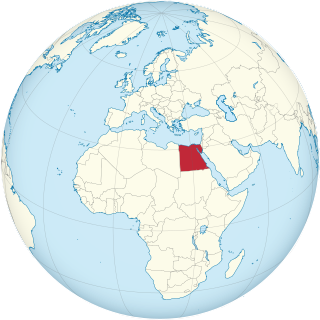
Articles related to Egypt include:

The necropolis of Draʻ Abu el-Naga' is located on the West Bank of the Nile at Thebes, Egypt, just by the entrance of the dry bay that leads up to Deir el-Bahari and north of the necropolis of el-Assasif. The necropolis is located near the Valley of the Kings.

The necropolis of Sheikh Abd el-Qurna is located on the West Bank at Thebes in Upper Egypt. It is part of the archaeological area of Deir el-Bahari, and named after the domed tomb of the local saint. This is the most frequently visited cemetery on the Theban west bank, with the largest concentration of private tombs.

The necropolis of El-Khokha is located on the west bank of the river Nile at Thebes, Egypt. The necropolis is surrounds a hill and has five Old Kingdom tombs and over 50 tombs from the 18th, 19th and 20th dynasties as well as some from the First Intermediate Period and the Late Period.
Articles related to Modern Egypt include:
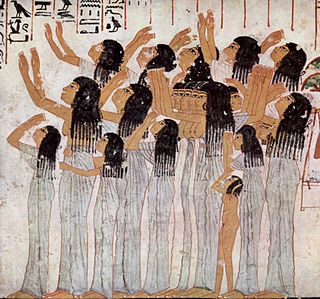
Ramose was an ancient Egyptian name, meaning "Ra is born". Variants of the name include Ramesses (Ramessu) and Paramessu; these various spellings could be used to refer to the same person.
The ancient Egyptian official named Menna carried a number of titles associated with the agricultural estates of the temple of Karnak and the king. Information about Menna comes primarily from his richly decorated tomb in the necropolis of Sheikh Abd al-Qurna at Thebes. Though his tomb has traditionally been dated to the reign of Thutmose IV, stylistic analysis of the decoration places the majority of construction and decoration of the tomb to the reign of Amenhotep III.

The High Priest of Amun or First Prophet of Amun was the highest-ranking priest in the priesthood of the ancient Egyptian god Amun. The first high priests of Amun appear in the New Kingdom of Egypt, at the beginning of the Eighteenth Dynasty.
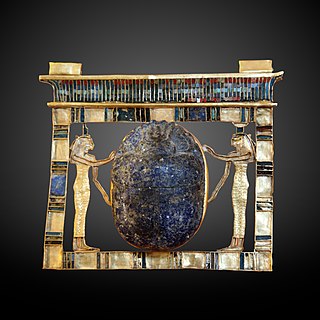
Paser was an ancient Egyptian noble who served as vizier during the reigns of Seti I and Ramesses II in the 19th Dynasty. He would later also become High Priest of Amun.
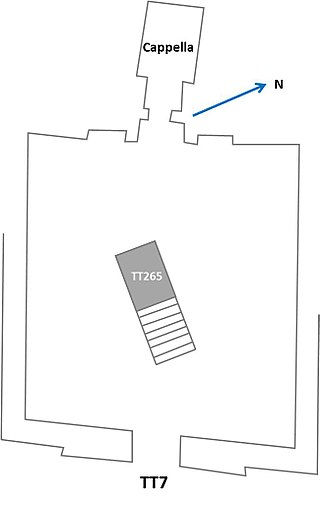
The Theban Tomb TT7 is located in Deir el-Medina, part of the Theban Necropolis, on the west bank of the Nile, opposite to Luxor. It is the burial place of the ancient Egyptian artisan named Ramose, who lived during the 19th Dynasty, during the reign of Ramesses II.

Ramose was an ancient Egyptian scribe and artisan who lived in Deir el-Medina on the west bank of the Nile, opposite Thebes, during the reigns of Ramesses II. He held the position of Scribe of the Tomb, the highest administrative position for a scribe in Deir el-Medina, from around years 5 to 38 of Ramesses II's reign. He was buried in a tomb in the village necropolis.

Nakhtmin held the position of generalissimo during the reign of pharaoh Tutankhamun of the Eighteenth Dynasty of Ancient Egypt. His titles during the reign of Tutankhamun included "the true servant who is beneficial to his lord, the king's scribe," "the servant beloved of his lord," "the Fan-bearer on the Right Side of the King," and "the servant who causes to live the name of his lord." These titles were found on five ushabtis that Nakhtmin offered as funerary presents for pharaoh Tutankhamun.
The ancient Egyptian Branch hieroglyph, also called a Stick, is a member of the trees and plants hieroglyphs.

Bakenkhonsu was a High Priest of Amun in ancient Egypt during the reign of Pharaoh Ramesses II. Information about his life was found on the back of his block statue. The information on the statue provides details about the education of young Egyptian noblemen at that time and the career of priests.
Mutnedjmet was an ancient Egyptian queen of the 21st Dynasty. She was the Great Royal Wife of her brother, Psusennes I.
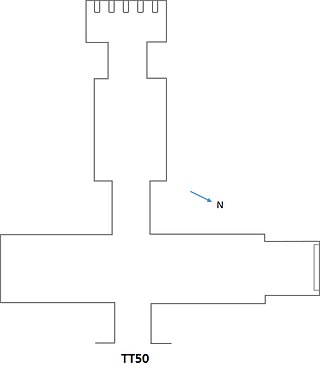
The Theban Tomb TT50 is located in Sheikh Abd el-Qurna, part of the Theban Necropolis, on the west bank of the Nile, opposite to Luxor. It is the burial place of the ancient Egyptian official Neferhotep, who was a Divine father of Amun-re during the reign of Horemheb of the 18th Dynasty.

The Theban Tomb TT282 is located in Dra' Abu el-Naga', part of the Theban Necropolis, on the west bank of the Nile, opposite to Luxor. It is the burial place of the ancient Egyptian Nakhtmin, also called Nakht, who lived during the reign of Ramesses II of the 19th Dynasty.
This page list topics related to ancient Egypt.

Tomb TT374, located in the necropolis of El-Khokha in Thebes, Egypt, is the tomb of the Scribe of the Treasury of the Ramesseum, Amenemope.

Tomb TT406, located in the necropolis of El-Assasif in Thebes, Egypt, is the tomb of Piay, a scribe of the offering table of the Lord of the Two Lands dated to the Ramesside period. It is located in El-Assasif, part of the Theban Necropolis.
















